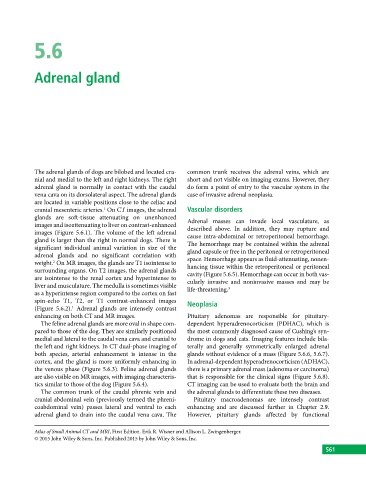Page 571 - Atlas of Small Animal CT and MRI
P. 571
5.6
Adrenal gland
The adrenal glands of dogs are bilobed and located cra- common trunk receives the adrenal veins, which are
nial and medial to the left and right kidneys. The right short and not visible on imaging exams. However, they
adrenal gland is normally in contact with the caudal do form a point of entry to the vascular system in the
vena cava on its dorsolateral aspect. The adrenal glands case of invasive adrenal neoplasia.
are located in variable positions close to the celiac and
1
cranial mesenteric arteries. On CT images, the adrenal Vascular disorders
glands are soft‐tissue attenuating on unenhanced
images and isoattenuating to liver on contrast‐enhanced Adrenal masses can invade local vasculature, as
described above. In addition, they may rupture and
images (Figure 5.6.1). The volume of the left adrenal
gland is larger than the right in normal dogs. There is cause intra‐abdominal or retroperitoneal hemorrhage.
The hemorrhage may be contained within the adrenal
significant individual animal variation in size of the
adrenal glands and no significant correlation with gland capsule or free in the peritoneal or retroperitoneal
space. Hemorrhage appears as fluid‐attenuating, nonen-
weight. On MR images, the glands are T1 isointense to
2
surrounding organs. On T2 images, the adrenal glands hancing tissue within the retroperitoneal or peritoneal
cavity (Figure 5.6.5). Hemorrhage can occur in both vas-
are isointense to the renal cortex and hyperintense to
liver and musculature. The medulla is sometimes visible cularly invasive and noninvasive masses and may be
life‐threatening.
3
as a hyperintense region compared to the cortex on fast
spin-echo T1, T2, or T1 contrast‐enhanced images Neoplasia
(Figure 5.6.2). Adrenal glands are intensely contrast
1
enhancing on both CT and MR images. Pituitary adenomas are responsible for pituitary‐
The feline adrenal glands are more oval in shape com- dependent hyperadrenocorticism (PDHAC), which is
pared to those of the dog. They are similarly positioned the most commonly diagnosed cause of Cushing’s syn-
medial and lateral to the caudal vena cava and cranial to drome in dogs and cats. Imaging features include bila-
the left and right kidneys. In CT dual‐phase imaging of terally and generally symmetrically enlarged adrenal
both species, arterial enhancement is intense in the glands without evidence of a mass (Figure 5.6.6, 5.6.7).
cortex, and the gland is more uniformly enhancing in In adrenal‐dependent hyperadrenocorticism (ADHAC),
the venous phase (Figure 5.6.3). Feline adrenal glands there is a primary adrenal mass (adenoma or carcinoma)
are also visible on MR images, with imaging characteris- that is responsible for the clinical signs (Figure 5.6.8).
tics similar to those of the dog (Figure 5.6.4). CT imaging can be used to evaluate both the brain and
The common trunk of the caudal phrenic vein and the adrenal glands to differentiate these two diseases.
cranial abdominal vein (previously termed the phreni- Pituitary macroadenomas are intensely contrast
coabdominal vein) passes lateral and ventral to each enhancing and are discussed further in Chapter 2.9.
adrenal gland to drain into the caudal vena cava. The However, pituitary glands affected by functional
Atlas of Small Animal CT and MRI, First Edition. Erik R. Wisner and Allison L. Zwingenberger.
© 2015 John Wiley & Sons, Inc. Published 2015 by John Wiley & Sons, Inc.
561

